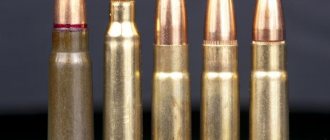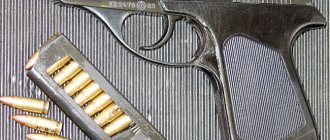Signal torch
All people who love active recreation sooner or later find themselves in an unpleasant situation in which it is necessary to attract attention due to a disaster or an attack by wild animals. But how and with what to attract attention, or, on the contrary, scare away this attention from yourself? Alas, not everyone knows.
Ground signal cartridges red, green and yellow lights
Ground signal cartridges 1 and 2 (Fig. 24) of red, green and yellow lights consist of a paper body, a signal star 4, an igniter 5, a cover 11 with a ring and handles 16 with a holder 15. Fig
. 24. Ground signal cartridge for night action of red (green or yellow) light and its components:
1 — cartridge with folded handles; 2 — cartridge with folded handles; 4 — signal star;
5 — ignition device; 11 — cover with a ring; 15 — holder; 16 – handles
Housing 3 (Fig. 25) serves to house the signal star 4 and the ignition device and to protect them from mechanical influences and moisture. The outer surface of the case is painted with protective paint.
Signal star 4 gives a red (green or yellow) light signal when burning. It consists of a block, pressed from a pyrotechnic composition, and a paper shell.
The ignition device serves to ignite the signal star. It consists of a grater primer 7 with a grater 6, fixed in a plastic diaphragm 5, and a cord 9 with a button 13 attached to the grater. The primer, grater and cord are the same as those used in the 30mm and 40mm rocket illumination cartridges.
Diaphragm 8 has four holes through which, under the action of the cartridge, the combustion products of the signal star exit the housing.
Cardboard stops 14 and a cardboard washer 12 are used to secure the signal star and ignition device in the cartridge body.
Rice. 25. Ground signal cartridge for night action of red (green or yellow) light (section):
3 - body; 4 - star; 5 - grater; 7 — igniter primer; 8 - diaphragm; 9 — exhaust cord;
10 - ring; 11 - cover; 12 — washer; 13 — button; 14 — stops; 15 — holder; 16 — handles; 17 - bottom
The metal cover 11 covers the cartridge from above and protects its equipment from mechanical influences and moisture.
Handles 16 serve to hold the cartridge at the moment of putting it into action. When carrying a cartridge, the handles should be folded along its body.
Holder 15 is used for attaching handles. It is a metal circle with cutouts for attaching handles.
Action of the cartridge. When you pull the cord, the igniter primer ignites due to the friction of the float against the float composition. A beam of flame from the primer ignites the signal star. When the signal star burns, a red (green or yellow) flame is formed.
The ring 10 attached to the cover 11 is intended for its removal when preparing the cartridge for action.
Use of signal colors, safety signs and signal markings
A safety sign is a color graphic image of a certain geometric shape using signal and contrasting colors, graphic symbols and/or explanatory inscriptions, intended to warn people about immediate or possible danger, prohibit, order or permit certain actions, as well as for information about the location of objects and means, the use of which eliminates or reduces the impact of hazardous and/or harmful factors.
Safety signs can be: basic, additional, combined and group.
- Basic safety signs contain an unambiguous semantic expression of safety requirements. Basic signs are used independently or as part of combined and group safety signs.
- Additional safety signs contain an explanatory inscription and are used in combination with the main signs.
- Combined and group safety signs consist of basic and additional signs and are carriers of comprehensive safety requirements.
Safety signs according to the types of materials used can be: non-luminous, retroreflective and photoluminescent; according to design - flat or three-dimensional. Metal, plastic, silicate or organic glass, self-adhesive polymer films, self-adhesive paper, cardboard and other materials are used as carrier materials.
Safety signs are placed (installed) in the field of view of the people for whom they are intended. They are located in such a way that they are clearly visible, do not distract attention and do not create inconvenience when people perform their professional or other activities, do not block the passage, passage, or interfere with the movement of goods.
The main signs are usually divided into the following groups:
- Prohibition signs;
- Warning signs;
- Fire safety signs;
- Mandatory signs;
- Evacuation signs;
- Medical and sanitary signs;
- Directional signs.
The shape of the main safety sign is: circle, triangle, square or rectangle.
Additional safety signs are used in combination with the main signs and are used in cases where it is necessary to clarify, limit or strengthen the effect of the main safety signs, as well as for information. As a rule, additional signs are located below or to the right or left of the main sign. The shape of additional safety signs is a rectangle.
Orange Smoke Daytime Ground Flare Cartridge
The ground signal cartridge 1 (Fig. 26) of orange smoke consists of a paper body, two ignition tablets 4, two smoke bombs 3, an ignition device 5 and a cover 15 with a ring 14.
Rice. 26. Orange smoke ground signal cartridge and its main parts:
1 - cartridge; 3 — smoke bombs; 4 - flammable tablets; 5 - ignition device; 14 - ring; 15 - cover
Housing 2 (Fig. 27), ignition device and cover 15 with a ring are designed similarly to the corresponding parts of a ground signal cartridge of red (green or yellow) light and are intended for the same purposes,
Rice. 27. Orange smoke ground signal cartridge (cut):
2 - body; 3 — smoke bombs; 4 - flammable tablets; 6 — lower stop; 7 - grater; 8 – igniter primer;
9 - diaphragm; 10 — exhaust air; 11 — upper stop; 12 — washer; 13 — button; 14 - ring; 15 - cover; 16 - bottom
Smoke bombs 3 are pressed from a special pyrotechnic composition and produce orange smoke when burned.
Ignition tablets 4 are designed to improve the ignition of smoke bombs; they are made from a pyrotechnic composition and black gunpowder.
Action of the cartridge.
When the cord is pulled, the igniter primer ignites. The beam of flame from the primer ignites the tablets, which in turn ignite the smoke bombs. When the checkers burn, orange smoke is produced, which exits the cartridge body to the outside through holes in the diaphragm.
Signal torch (smoke).
The smoke torch is designed to create colored smoke and bright fire. Possible colors are white, yellow, blue, red, orange, green.
The use of torches is very diverse; as a rule, we most often see them in everyday life - at holidays, at photo shoots, at football matches. But this invention can save your life in an emergency situation.
Signal torch
By taking several of these torches with you on a hike, you can be sure that you are safe. With it, you can both illuminate the area around you and send a distress signal.
To activate the torch, you need to pull out the cord with the ring. The most common color is red, as this color signals danger and attracts attention more, with an approximate burn time of 5 minutes.
Consists of a waterproof housing filled with a flammable composition. The cost of one such torch ranges from 200 to 500 rubles.
Old style ground signal cartridges
Old-style ground signal cartridges have a metal body (Fig. 28 and 29), which is why they differ from the cartridges described above. There is a thread on the top of the body onto which a metal cap is screwed. The lanyard for the red, green and yellow light sockets is attached to the ring, and for the orange smoke socket it is attached to the cap. Between cap and body
| Rice. 28. Old-style red (green or yellow) night-action ground signal cartridge and its main parts: 1 - cartridge; 2 - body; 3 — handles; 4 — exhaust cord; 5 - cap; 6 - gasket; 7 – ring | Rice. 29. Old style orange smoke ground signal cartridge and its main parts: 1 - cartridge; 2 - body; 3 — exhaust cord; 4 - cap; 5 – cartridge gasket is sealed with a rubber gasket. |
In their action, old-style cartridges do not differ from the paper-cased cartridges described above.
Markings and identification marks of ground signal cartridges
The bodies of ground signal cartridges are marked with the factory number or symbol, batch number of the cartridges, year of manufacture and purpose of the cartridge.
In addition, the red, green and yellow light cartridges have special colored and raised identification marks to identify the purpose during the day and night (Fig. 30).
Rice. 30. Identification marks of ground signal cartridges:
1 - red light; 2 — green light; 3 - yellow light
To identify cartridges in the daytime, the cartridge covers are painted in a color that matches the color of the fire. To recognize cartridges at night, there are raised identification marks on the covers. The red light ground signal cartridge has one round bulge, while the green light ground signal cartridge has two round bulges. The cover of the yellow light cartridges is smooth, without bulges.
The orange smoke cartridge does not have special colored or raised identification marks.
For old-style red, yellow and green light cartridges, the entire cap is painted in the signal color. The raised identification marks on the caps are the same as on cartridges in a paper case.
Old style orange smoke cartridges have a red cap; there are no prominent identification marks on it.
Safety and precautions when handling ground flare cartridges
When handling ground signal cartridges, the following safety precautions and precautions must be observed.
When activating the signal cartridge, keep the top part away from you.
Do not throw a burning cartridge onto flammable objects, as this may cause a fire.
Remove covers and unscrew caps from cartridges only before giving a signal.
Storage and transportation of cartridges without lids or caps is not permitted, since if the lanyard is caught on any object, the cartridge may spontaneously ignite, which can cause severe burns to people or a fire.
Cartridges with dented bodies, cracks in the bodies or bulging bodies must be removed from circulation and destroyed; The use of such cartridges is prohibited. It is prohibited to discharge ground signal cartridges.
aliens Signal smoke-aliens
What kind of signal smoke do aliens use?
Astronomer Geoffrey Marcy, one of the leading experts on exoplanets, now plans to search for more complex objects - alien civilizations. According to him, he knows why this activity has not yet been successful.
The good news is that, in his opinion, extraterrestrial civilizations (ECs) do not need to be somehow encouraged to communicate with us and wait for many years for our signals to reach them (and vice versa). The fact is that if there is more than one civilization, then they must inevitably be in contact with each other, and actively, because in the search for computer centers it has long been considered an axiom: if computer centers exist at all, there are a lot of them. Modern research in the field of exoplanets seems to have confirmed this: even Alpha Centauri, the closest to Earth, may have planets in the habitable zone, and at least a third of the solar systems of the Galaxy have terrestrial-type planets in the habitable zone. In terms of numbers, this is tens of billions.
The bad news, however, is that all SETI efforts (and all alien-hunting efforts in general) were in vain. In essence, we tried to communicate with the EC using signal smokes and native drums, while they have long been using much more effective means of communication, which we simply did not know about until recently. “They won’t run fiber optic cables between stars, they will communicate using lasers,” Mr. Marcy believes.
The SETI project has been ongoing for decades. But was it thought out from the very beginning? Where did the confidence come from that the “aliens” use the radio? (Photo by Dave Fayram.)
Why? Radio emission is incoherent, requires huge antennas and receivers, and is affected by interference from the natural interstellar background. Using an analogy, we can say that a signal fire visible 1,000 km away will be very large and difficult to organize, and clouds in the area of the “receiver” can reduce its effectiveness as an information carrier to zero. The efficiency of radio communication at the same distance will be higher, and the amount of energy spent on this communication will be less. When communicating between civilizations, it is necessary to use the most coherent emitters possible, capable of “getting into the spaceship of another civilization at another star,” says Jeff Marcy. And this is good, because it means that thousands or millions of laser beams (more precisely, their reflections) must constantly circulate throughout the Galaxy, since when receiving a laser beam, the latter must be partially reflected from the receivers.
Moreover, the astronomer notes, computer centers may well already be aiming their lasers in our direction, and we do not notice the light spots from them only because we do not think about the need to conduct appropriate observations. A similar situation would have arisen if Marconi or Popov had wanted to communicate with the natives in the Amazonian jungle using radio.
According to the scientist, the discovery of Earth by aliens is almost inevitable. “In the next century or two, we humans will have telescopes with reflecting mirrors scattered from Earth to Jupiter, simulating the operation of a single optical telescope with colossal angular resolution,” says Mr. Marcy. In fact, such systems are already used - in telescopes such as the VLT, for example. All that remains to be done is to deliver the reflecting mirror to the orbit of Jupiter. The presence of such telescopes means that “we should one day [in the future] see continents on other [exo]planets.” Obviously, advanced computer centers already have this capability. After all, as is now clear, stars with a high level of metallicity (that is, with a large number of Earth-like planets) existed already 10 billion years ago, and therefore our “competitors” had a lot of time to develop.
Even our spacecraft are increasingly using lasers for ranging, etc. It may happen that in doing so we unintentionally give ourselves away to other civilizations. (Photo by Wikipedia.)
Moreover. Ground-based telescopes of earthlings use their own lasers in adaptive optics systems. With their help, atmospheric aberration is corrected. Of course, “we have already sent signals revealing our existence” to many objects from star catalogs. Of course, so far they have only sent: even at a distance of 1,000 light years, traces of our lasers will only be discovered after many centuries. But when this happens, the ECs of that area immediately use their telescopic systems to closely study the Earth. If they want to communicate, they will send highly coherent laser pulses, says Geoffrey Marcy, so we urgently need to organize tracking of such signals.
In order not to be the last to realize the massive discovery of the Earth by other computers, the astronomer believes, you need to have space-based telescopes much larger than Kepler: something like the Terrestrial Planet Finder or Darwin rejected for financial reasons.
Note that the active communication model of the EC that astronomers assume is based on the assumption that the model of alien societies is close to the current Western one, that is, it means active peace and friendship with other civilizations. However, Earth's history demonstrates other types of communication with outside civilizations, such as the approach of the Mongol Empire at its height and the Japanese "country on lock" model. It is likely that CC has other approaches that are equidistant from the three listed above.
Prepared from NewScientist.










